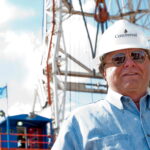From The Casper Star-Tribune
Until recently, people in Cheyenne, Wyoming would rarely encounter a drilling rig close to home. They might spot the light of a flare in the dark distance, like a candle flickering above the prairie, but the industry fueling Wyoming’s economy largely operated out of sight.
As the Capitol City has expanded outward and oil and gas development multiplied in the DJ Basin, more people in the southeastern corner of Wyoming are now coming into contact with the apparatus of industry.
That change is a fraction of what has happened just over the southern border in Colorado.
The proximity of industry to homes, schools and stores has created a conflict in that state that could shift oil and gas’ future, not just in Colorado, but in Wyoming as well.
The Colorado Secretary of State’s office affirmed Wednesday that a citizen’s initiative increasing to 2,500 feet the required distance between wells and homes will be on the November ballot. Because of urban sprawl in many parts of Colorado, the setback could effectively shut down new drilling in all but isolated parts of the state.
In Wyoming, where the populace and politics tend to be friendlier toward oil and gas, it’s difficult to gauge the magnitude of Colorado’s coming decision, from the potential damage to regional businesses based in Laramie County to the possibility of new investments in Wyoming’s oil and gas fields.
There is one thing that seems certain: the outcome in Colorado could significantly change the oil and gas game in Wyoming.
“There could be a net positive for Wyoming, but maybe it’s a net negative,” said Scott Prestidge, of the Colorado Oil and Gas Association. “It’s hard to tell how wide and broad those impacts could be because this is uncharted territory.”
Unintended consequences
Colorado’s current setback rules keep drilling 350 feet from outdoor areas like playgrounds, 500 feet from homes and 1,000 feet from schools or hospitals. The initiative would create a blanket setback of 2,500 feet, five times the current setback rules in Wyoming. Counties and cities would also be free to increase the setback further within their jurisdiction.The Colorado Oil and Gas Association estimates that the proposed setback would remove $218 billion from the state’s GDP between now and 2030, at a rate of $26 billion per year. The job loss is estimated at 147,000 according to association. The majority of the jobs are indirectly associated with the oil and gas business, from lawyers to welders.
“We fully believe the writers of the measure are trying to do what it looks like they are trying to do, which is ban development,” Prestidge said. “It’s basically reverse economic development.”
James Parrot, an oil and gas lawyer for Beatty Wozniak in Denver and a former landman, said some of the unintended consequences of this initiative aren’t being considered. It could push out the large players who have long-term commitments to the communities and stronger safety standards. But it won’t wipe out everyone.
“The groups that would like to see an end to oil and gas development in Colorado may see the exact opposite of what they would like, riskier companies coming into fill the void when safe, responsible companies end up leaving.”
Those supportive of the measure say the losses are worth it for Colorado, pointing to a diversified economy that can bear the job drain in favor of a greener energy sources. Some have cited the gas explosion from an Anadarko well in 2017 that killed two men in their Firestone home as evidence of the safety concerns with industry in communities.
Wyoming draw
Regardless of the divided opinion in Colorado, Wyoming could experience a significant boost if the measure passes.
“You are going to drive most of the oil and gas out of Colorado. It’s got to go somewhere,” said Brian Jeffries, executive director of the Wyoming Pipeline Authority. “Wyoming is in the queue for where dollars get spent, along with whether they go to the Permian or North Dakota, or back to Ohio and Pennsylvania.”
In Wyoming’s favor is its proximity. Large independents like Anadarko Petroleum have investments on both sides of the border.
Uncertainty about Colorado politics has long been a consideration for larger firms, but the coming change could give Wyoming an edge and drive more dollars into drilling the state’s oil and gas fields, a push that will be visible in places like Casper and Pinedale, insiders say.
There’s been particular interest growing in the Powder River Basin, where Anadarko already has significant lease holdings and where drilling interest from large players has spiked.
Anadarko alone has more than 5,000 permits to drill in Wyoming, topped only by EOG Resources.
“Anadarko is huge in the DJ (Basin) since they own the minerals,” said Thomas Shanor, a lawyer that represents mineral owners in Wyoming. “If they can’t develop those, they are probably going to move rigs up to Wyoming. They’ve got a huge position in the Powder that they are really spending no money on exploration.”
Infrastructure could also tip Colorado investment into Wyoming. Producers are sitting on long-term contracts brokered with midstream operators to take oil and gas out of the Denver Basin. They’ll be looking for areas to drill that can be served by their existing pipeline commitments, said Jeffries of the Wyoming Pipeline Authority.
“That bodes well for Wyoming,” he added. “It’s a factor that could come into play in the capital reallocation.”
Headquarter of the Rockies
Of course it’s not only drillers that would be affected by a change of this magnitude in Colorado. As Wyoming knows well, the oil and gas industry isn’t insulated from the communities around it. In southern Wyoming, particularly Cheyenne, the well service companies and industry employers serve the northern Colorado fields as much, if not more, than Wyoming, said Randy Bruns, CEO of Cheyenne LEADS, an economic development group.
Ahead of the vote, it is difficult to calculate what could happen to the local economy as a result, he said.
“The uncertainty now has started, and uncertainty is difficult for everybody,” Bruns said. “Business and industry tends to grow cautious and not expand in the face of uncertainty.”







